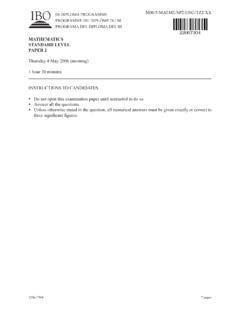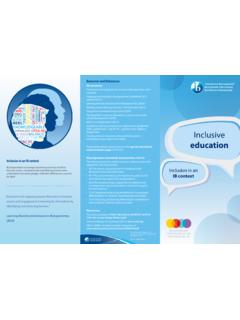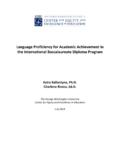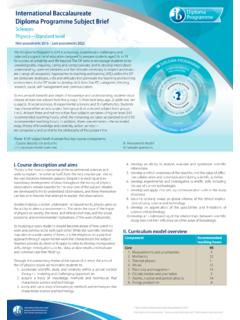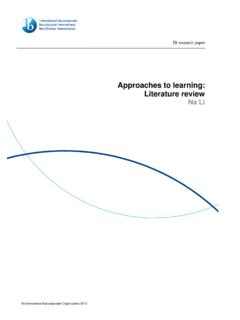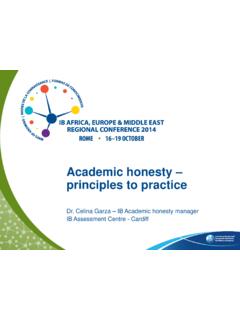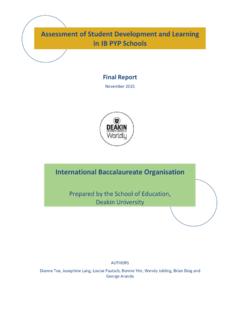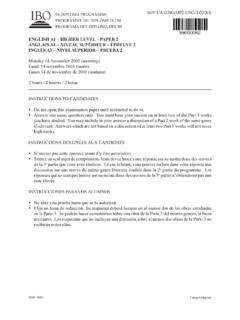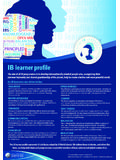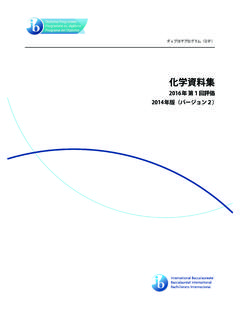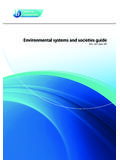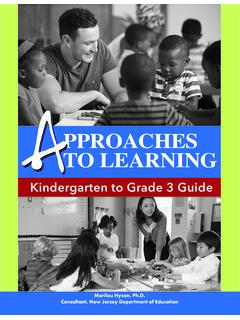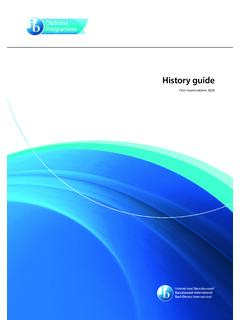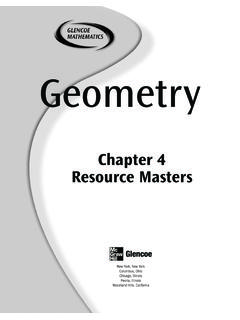Transcription of Guide for IB students applying to UK institutions
1 Guide for IB students applying to UK institutionsThis Guide provides a brief introduction to the UK higher education system and its application process, as well as information specifically relevant to IB students applying to UK institutions from outside of the UK contextThe UK includes the countries of England, Scotland, Wales and Northern Ireland. There are more than 160 universi-ties and colleges in the UK, offering a variety of options for students pursuing degrees in higher education. This Guide provides information primarily for those applying to degree-granting universities. However, attending a degree-granting university, a listed body or pursuing a career after completing the IB Diploma Programme are all viable bodiesThere are more than 700 colleges and other institutions known as listed bodies that do not grant degrees but of-fer courses that could lead to a degree at a degree-grant-ing university.
2 These listed bodies each have their own application system. Degree lengthThe same government regulations and processes apply to all four countries in the UK, so the application process for universities and colleges is consistent throughout. However, Scotland has a different system of education from the others, so there are important differences to note. Most degrees in the UK can be completed in three years, but Scottish courses of study typically take four years. A sandwich year is becoming more popular in UK universities, in which students spend one year (usually their third) in the workplace before returning to the uni-versity to finish their to UK universitiesUCASThe application process in the UK is typically done through the UK s centralized admissions body, the Universities and Colleges Admissions Service (UCAS).
3 students fill out one form, upload a personal statement and include one reference. Their school should submit their IB predicted grades. students then identify up to five courses to which they would like to apply (four in the case of clinical programmes such as medicine or dentist-ry). The five courses can be at five different universities, or students can apply to two or more courses at the same an area of studyWhen applying to UK universities, students must indicate the specific course of study (also referred to as a subject) they are planning to pursue. The classes students take throughout their three or four years will be focused on this subject (for example, Psychology, Business Manage-ment, Biology, Design). If a student chooses to switch course, he or she will need to reapply and possibly restart his or her studies from the beginning.
4 Thus, it is important for applicants to be clear about what they would like to study at the time of their university application. Some universities have the option to combine courses, such as Human Geography and French. Universities in Scotland tend to have a more liberal arts and flexible approach, allowing students to take classes outside of their course of search for courses of interest, students can use the Find a course section on the UCAS website. It shows which courses are offered by different universities and allows students to find out more about the universities that interest them. The Unistats website can be used to compare courses offered at different universities. Many universities have requirements for specific Diploma Programme courses to be taken at higher level (HL); for example, most Engineering courses require mathemat -ics and physics to be taken at HL.
5 The Russell Group is also a good place to get information for choosing which subjects to take. Entry requirementsOnce students are ready to apply for particular courses, they can view the entry requirements listed on the UCAS website or on the individual university s site. Each UCAS university listing provides information about why some-one would study that course, the key skills and qualities the school looks for in applicants, where to obtain more information and what academic qualifications are need-ed. It also indicates the required points for the IB diploma in order to gain a conditional offer from the university, as well as any point requirements for specific subjects (usually higher level subjects). Offers are confirmed once final results are should consider applying to a variety of under-graduate courses, including those whose entry require-ments are slightly above their anticipated IB marks, as there might be some flexibility when it comes to final offers due to that year s course cohort and the individ-ual student s profile.
6 It is important to apply to courses whose entry requirements are lower than the student s current standing as well, to ensure the best possible chance of receiving institutions may have additional requirements, such as interviews or entrance exams. students from non-English speaking backgrounds may also need to consider any language proficiency requirements set by the individual institutions . UCAS Tariff pointsThe Tariff is a point system that UCAS uses to allow for comparisons to be made between students applying from a variety of programmes (including the IB). Not all qualifications are allocated Tariff points, and not all universities use the Tariff when evaluating applicants; nonetheless, it is a good idea for IB students to be familiar with the Tariff point system.
7 Tariff points can be calculated based on individual IB scores as well as the total IB score, and conversion tables are available on the Tariff page of the UCAS submitting the applicationStudents can stay up to date about their applications through the Track feature on the UCAS website. When a university has made a decision about a student s appli-cation, it will be communicated through Track, and the student will also receive formal notice. Gaining an offerUK universities generally do not give outright acceptanc-es; instead, they give students offers that are contingent upon the students fulfilling certain conditions. Conditions include a minimum number of points for IB diploma re-sults, and some universities require a minimum score on specific IB subjects.
8 A university might choose to decline an application rather than giving an offer. On occasions, a university might give a student an unconditional offer, meaning the student has been accepted to attend that university even before final scores are made an offerOnce students have received a conditional decision from the courses to which they applied, they then respond to the offers. They must choose one course offer to be their Firm offer, indicating that it is their first choice, as well as one Insurance offer, in case they do not meet the minimum requirements of the Firm offer (understanding that the student will also need to meet the minimum requirements of the Insurance offer). All other offers must be declined. This can be a difficult decision, so students are advised to discuss this decision with their counsellor.
9 Final offers are made after results are released. Timeline There is a timeline on the UCAS website that outlines the key dates for application. Most courses have a mid-Jan-uary deadline for applying through UCAS. For offers communicated before March 31, students must reply by May 5. For offers communicated in May or June, stu-dents must reply by mid- to late-June. Once IB results are released in July, scores should be sent as soon as possible to determine whether conditional offers are satisfied or not. Information for IB students The IB diploma is widely known and accepted as a qualifying programme to attend university in the UK. Individual courses and universities typically have specific IB diploma and individual subject score requirements, so it is important to be aware of the requirements for the courses in which a student is interested.
10 Given the specialized nature of UK undergraduate degrees, course selection and scores in higher level courses are import-ant in the admissions process. Most programmes will set prerequisite scores for particular courses in addition to an overall points total. The offers given by universities to IB applicants are based on final IB results. There is typically no advanced standing given to students based on their scores, although some Scottish programmes might offer advanced standing due to their programmes being four years. Release of resultsWhen IB results are released, the results are sent to the universities of their Firm and Insurance offers. Note that candidates must give permission to their school for their results to be released to UCAS and the universities.
